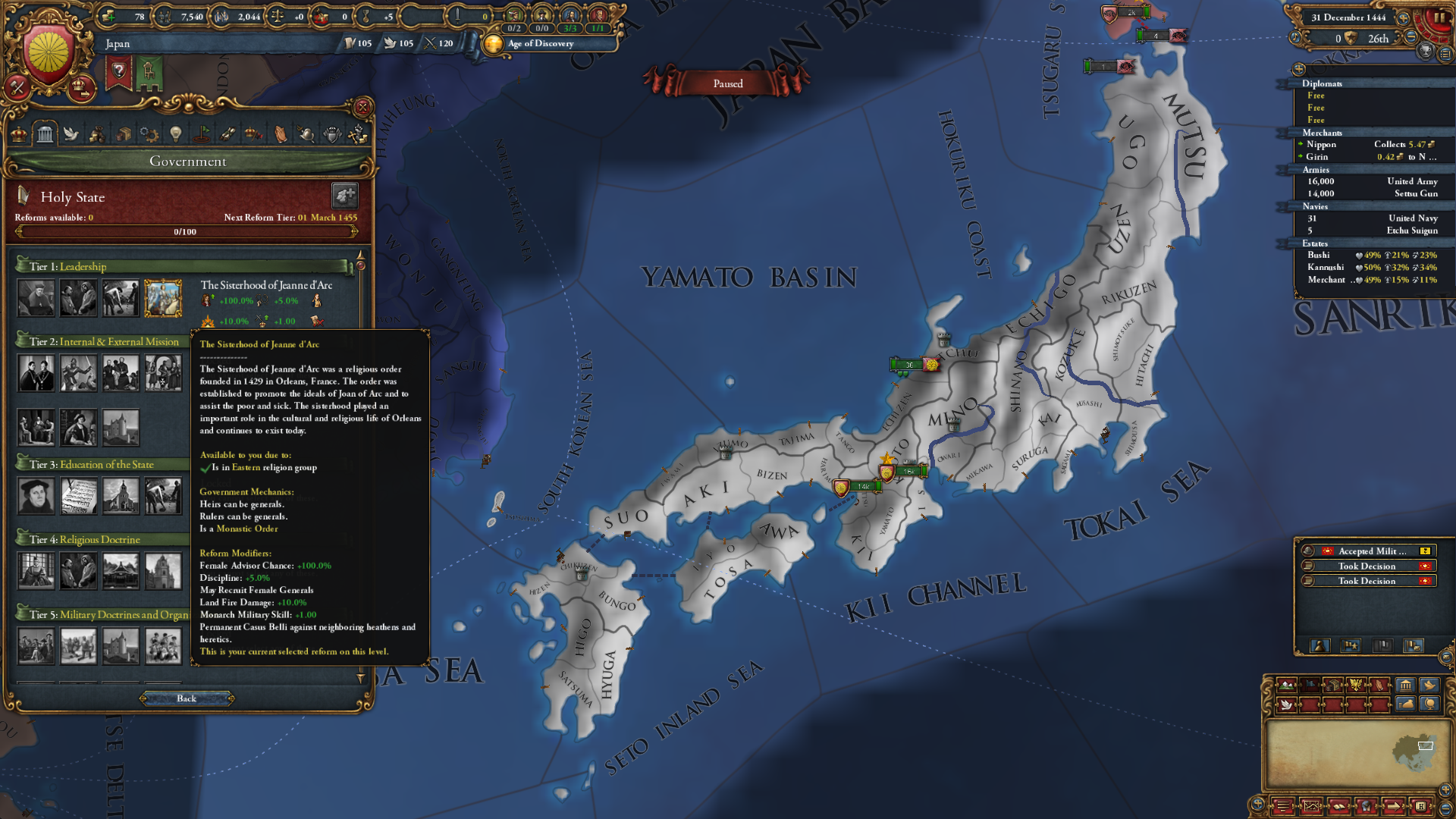THE "ITTO JIDAI" ERA - ERA OF UNITY - 1332 - 1444
United. Japan is finally united. For the first time in centuries, the dust has settled. The weapons have fallen silent. There is only one power, and it is absolute and final. Guided by the Tenkabito, the country begins a long period of prosperity.
It is generally accepted that Japan was united by the three successive Tenkabito of the Hirata family. Prior to that, the archipelago was plagued by incessant civil wars, each more deadly than the last. The Emperor of Japan found himself deeply weakened: he no longer represented anything, having no army or truly loyal vassals. In fact, the lords first served the whims of the Tenkabito. The Emperor was confined to his role as the religious leader of the Shinto faith. Go-Kazan, the first monarch of this Era of Unity, immersed himself in it completely. He significantly increased his influence among the priests and the future castes of warrior monks. He was seen traversing the country from one end to the other to participate in numerous rituals and ceremonies.
He shared this religious role with his first wife, Shizuko Hirata, cousin of Tenkabito Naoto and, most importantly, granddaughter of Tenkabito Totane. Her ambition was great, as she desired to exercise more direct and greater power. If Go-Kazan was the high priest of the Shinto faith, Shizuko became the highest priestess. She established numerous female monasteries that quickly proved prosperous. They were like spices added to a subtle poison. Each one would produce new priestesses, wives for good families, and soon, imperial advisors.
Upon Go-Kazan's death, a new Emperor would take his place. This succession highlighted the major stake that the imperial harem represented: indeed, following Shizuko, the new first wife would enjoy considerable power. The nobles fought to install women devoted to their respective clans in the harem. Within the harem itself, incessant power struggles and cascading assassinations decided who would become the next O-Kannushi.
It is generally accepted that Japan was united by the three successive Tenkabito of the Hirata family. Prior to that, the archipelago was plagued by incessant civil wars, each more deadly than the last. The Emperor of Japan found himself deeply weakened: he no longer represented anything, having no army or truly loyal vassals. In fact, the lords first served the whims of the Tenkabito. The Emperor was confined to his role as the religious leader of the Shinto faith. Go-Kazan, the first monarch of this Era of Unity, immersed himself in it completely. He significantly increased his influence among the priests and the future castes of warrior monks. He was seen traversing the country from one end to the other to participate in numerous rituals and ceremonies.
He shared this religious role with his first wife, Shizuko Hirata, cousin of Tenkabito Naoto and, most importantly, granddaughter of Tenkabito Totane. Her ambition was great, as she desired to exercise more direct and greater power. If Go-Kazan was the high priest of the Shinto faith, Shizuko became the highest priestess. She established numerous female monasteries that quickly proved prosperous. They were like spices added to a subtle poison. Each one would produce new priestesses, wives for good families, and soon, imperial advisors.
Upon Go-Kazan's death, a new Emperor would take his place. This succession highlighted the major stake that the imperial harem represented: indeed, following Shizuko, the new first wife would enjoy considerable power. The nobles fought to install women devoted to their respective clans in the harem. Within the harem itself, incessant power struggles and cascading assassinations decided who would become the next O-Kannushi.
THE "HIKARI NO UNMEI" ERA (光の運命) - THE DESTINY OF LIGHT - 1444 - 1XXX
Each generation made the high priestesses more powerful and more ambitious. Our story resumes with O-Kannushi Makoto Hirata, from the Hirata clan. She becomes the Celestial Spouse of Japan on November 11, 1444, at the young age of 30. A new era begins. This is the Book of Water.



